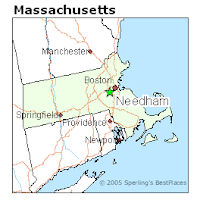Dedham was established in 1636 when the citizens of both Cambridge and Watertown, Massachusetts decided to establish two other plantations, one in Dedham, the other in Hartford, Connecticut. The General Court granted the original petitioners of Dedham 200 square miles of land south and west of Boston. The intent of these Puritans was to establish a Christian community, where its citizens would live by the Golden Rule, where differences between people would be settled by mediation, where citizens would donate time to maintain the community, and where town rules and policies would be followed. Their intention were contained in a document known as the Dedham Covenant. Those desiring to settle in Dedham need to be acceptable to the prior signers of the Covenant and were required to sign the covenant.
Over the years, Dedham went from a town of about 200 in 1640 to 24,729 at the 2010 census. In addition, due to increases in population, other towns-- Medfield (1651), Wrentham (1673), Needham (1711), Walpole (1724), Dover (1784), Norwood (1872), and Westwood (1897)were established from the land which had been granted to Dedham.
Twice I was able to visit Dedham. So here are some of the highlights of those trips.
The bus left me off on High Street, which is the town's main street.
 |
| HIgh Street |
 |
| Dedham Historical Society and Museum |
I also saw the Allin Congregational Church, which was established in 1637.
 |
| Allin Congregational Church |
Many of my ancestors are buried in The Village Cemetery. So I had to go there. I spent time looking at the Richards headstones and taking pictures of them.
 |
| Village Cemetery |
About 10 minutes from the town center is the Fairbanks House. My 8th great grandfather, Jonathan Fairbanks built this house in 1637. It is the oldest standing timber –frame house in North America. I walked over to it and had a wonderful tour. For more information about the house see #27--Jonathan Fairbanks--Building his Family a House
 |
| Jonathan Fairbanks House |



